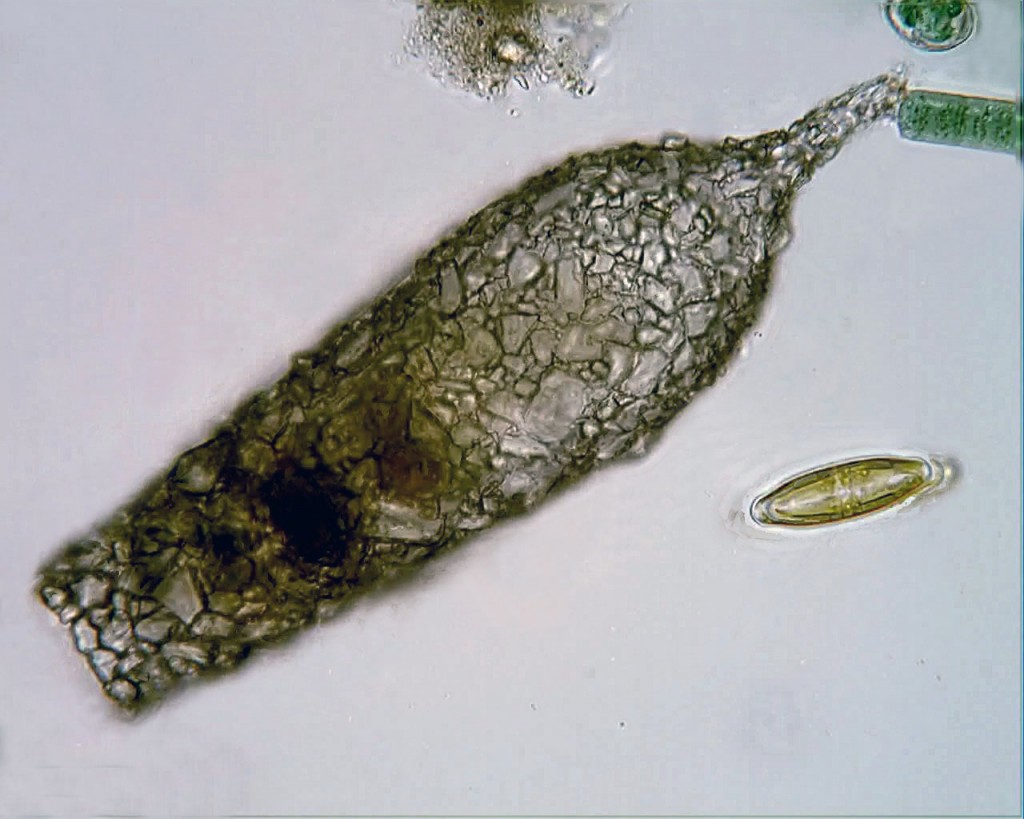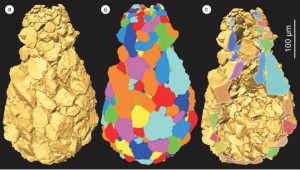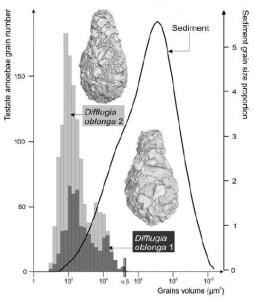I’ve added a number to the title of this post, because I expect to make “Protist Homes” a regular feature. I had intended it to be an idea-free zone, devoted to uncomplicated wonderment (kind of like the tours of celebrity homes and stately residences on HGTV). But I know some ideas and research will creep in, because it’s hard to feel wonderment without actually starting to wonder.
Consider the little shell in the image to the left. Barely two tenths of a millimetre long, it was constructed by an amoeboid, using found materials: tiny grains of sand, glued together with some sort of proteinaceous cement.
How does a single-celled amoeba build such a perfect bottle, from such randomly-shaped material? And why did my grade-school macaroni art projects turn out so much worse?
The organism that once lived in that test is dead (testate amoebae cannot leave their shells without dying). In life, it would have looked and behaved like the one in this video, by my fellow protist-watcher, Francisco Pujante:
All members of the genus Difflugia build their shells–or tests, as they’re properly called—out of stuff they find lying around, such as grains of quartz or discarded diatom shells, binding them into a matrix of organic secretions. It turns out that they are quite selective about the particles they use for this work, and researchers have gone to a lot of trouble to figure out what criteria amoebae use when picking their building materials.
Recently, a group in France went so far as to create complete three-dimensional reconstructions of two specimens of Difflugia oblonga, using a process called x-ray microtomography. They calculated the volume, shape and orientation of each grain in their specimen tests, and gathered information about the density and composition of the individual particles. Yes, you read that correctly: they analyzed and modelled every micro-sandgrain in amoeba shells that are themselves smaller than the grains of sand you might find on an ordinary beach.
Using all this data, they compared the composition of the tests to the natural sediments in the ponds where they were collected. From their analysis, it appears that these amoebae really are selecting the smaller grains, and also showing a taste for certain minerals (quartz is preferred, while the more abundant calcite is shunned). What’s more, the amoebae seem to be selecting materials with a consistent density, which the authors speculate is to ensure the test will be perfectly balanced!
The paper (du Châtelet et al, 2013), includes a handy graph, comparing the sizes of each of grain of sand in two Difflugia tests to a distribution plot of the size of sand particles in the surrounding pond sediment.
Building with quartz is fine, if you are lucky enough to live in the mud bottom of a pond where chunks of silicate minerals are available. But what if your habitat is a floating clump of algae in a mineral-poor spagnum pool? There, the best source of silicate particles might be the siliceous shells (frustules) of your fellow protists the diatoms, which have the ability to build their little glass canoes from dissolved silica (silicic acid) found in the water around them. The testate amoeba Difflugia baccillariarum–typically found in sphagnum pools, where sand is in short supply–has figured out how to glue diatoms around itself as a means of protection. I find these guys, sometimes, in samples from the Mer Bleue bog, and always stop to look at them. They are truly amazing:
It is hard not to admire this crafty amoeboid, building its home from the bodies of other organisms. Sitting here in my post-and-beam house, assembled from the trunks and branches of felled trees, I feel a certain kinship.



